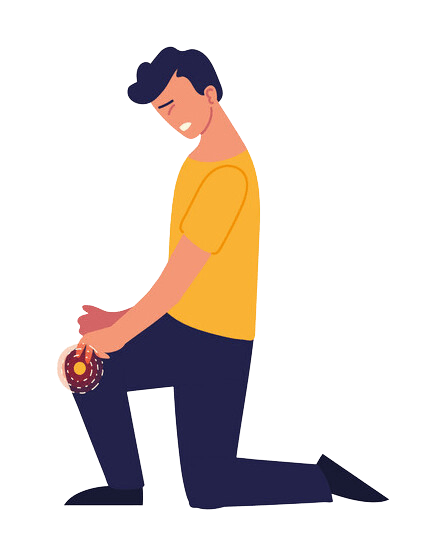Knee pain treatment online | Online Physiotherapy Clinic
- Affordable and reliable treatment for knee pain starting from $20 / session
- Video sessions with expert Physiotherapists/ PTs.
- Specialized physical therapy for knee pain, sprain, bursitis, or stiffness
Begin Therapy
Consult online with best Physios
A New model for Knee Pain Treatment
We understand that it’s difficult for most of us to find time for traditional knee physical therapy. Mantra Care brings to you online knee pain treatment, where all knee exercises and treatments are managed through regular online check-ins & video sessions.
Expert Physical therapists
Mantra Care members get matched with a professional physiotherapist for one-on-one knee pain treatment. They use interactive exercise videos available on our app to treat you.
Continuous Medical Care
Mantra Care physiotherapists are 100% virtual and provide physical therapy to patients without any time and geographical barriers. Our technology-enabled approach helps manage physical ailments from head to toe.
Personalized Knee therapy
MantraCare provides everyday exercises, home remedies, and regular check-ins for all your knee pain physiotherapy needs. We individualize treatment for each person, with problems including knee pain, muscle injuries, sprain, bursitis, stiffness, and more.

Best knee Pain Clinic, Now In Your Pocket
Our physical therapists or PTs are available in all parts of the world via an easy-to-use mobile application. The use of artificial intelligence, and data science enables the patients to connect with expert physiotherapists and get real-time insights into their knee health.

How it works

Signup for our knee Treatment Program
Just fill up a 5-minute online form to tell us about your knee pain history and treatment expectations.

Meet your PT
We will connect you with a physiotherapist who is available 24/7 to you via call or chat.

Connect to our app
Get Physical Therapy sessions on our app via video calls. Follow exercises suggested by our PT and track your progress in the app.
Meet the best online physical therapist
MantraCare physical therapists treat muscle and joint pain problems through a combination of body exercises, video demonstrations, and a healthy diet. Our treatment experience is a better traditional in-person approach in multiple ways.

Dedicated Physio
You get a personal Physio who customizes the exercise plan based on your comfort and needs

App-guided Exercises
3D animations & voice narrations in our app ensure proper and right guidance

Expert care anywhere, anytime
With over 200+ physios, MantraCare is 100% online – no waiting rooms

Exercise Kit
Complete exercise kit with elastic bands, door anchor, and a phone stand – mailed to you
A Complete Guide About Knee Pain Physiotherapy
Understanding Knee Pain
Knee pain is one of the most common complaints that come from people from all age groups. It can be a result of an accident or an injury in the knee portion of the leg, that causes a ruptured ligament for torn cartilage. It can also come from medical conditions like arthritis, gout, and other infections. The only treatment for recurrent knee pain is self-care and physiotherapy. It can help relieve the pain and never allows it to come back. In most cases, it may require surgical repair and physical therapy afterward.
Symptoms Of Knee Pain
As the problem occurs in the knee, the position and severity of the knee pain may vary. Some signs and symptoms that are evidently visible are:
- Inflammation and stiffness
- Redness and warmth to the touch
- Weakness or instability
- Popping or crunching noises
- Inability to fully straighten the knee
Causes Of Knee Pain
There can be many causes of knee pain, like injuries, different types of arthritis, some mechanical problems, and others.
Injuries
Various ligaments, tendons, and bursae are affected by a knee injury. It surrounds the knee joint as well as the bones, cartilage, and ligaments are responsible for the formation of the joint itself. Some very common knee injuries are:
- ACL injury: An ACL surgery is done to signify the tear in the anterior cruciate ligament (ACL). It is one of the four ligaments that act as a connection between your Shinbone and thigh bone. The surgery is particularly common in people who are basketball players who are involved in other sports like soccer, which requires a certain change in direction.
- Fractures: The knee bones are very prone to be broken in the cases of falls or auto accidents. At the same time, People who have weaker bones due to lso, osteoporosis can sometimes sustain a knee fracture simply by stepping wrong.
- Torn meniscus: The tough and rubbery cartilage that acts as a shock absorber between your shinbone and the thigh bone is called the meniscus. It can easily break down if you used your name while bearing weight on it.
- Knee bursitis: Some knee injuries cause inflammation in the bursae. These are the small sacs of fluid that fill the outside portion of your knee joint so that tendons and ligaments glide smoothly over the joint.
- Patellar tendinitis: It is one of the most common reasons for irritation and information between one or more tendons, which are the thick, fibrous tissues that attach muscles to bones. This swelling can be caused due to an injury in the patellar tendon that starts from the knee cap and runs to the shinbone. It allows you to kick, run and jump. Runners, skiers, cyclists, and those involved in jumping sports and activities may develop patellar tendinitis.
Mechanical problems
Some examples of mechanical problems that can cause knee pain include:
- Loose body: Sometimes an injury or degeneration in the bone or cartilage of the knee can cause some part of the bone and cartilage to break off and float in the space of the joint. It may not create any problem as such unless the loose body interferes with the movement of the knee joint.
- Iliotibial band syndrome. This generally happens when a rough band of tissues from outside of your hip to the outside of your knee becomes so tight that it starts rubbing against the outer portion of your thigh bone. Distance runners and cyclists are especially susceptible to iliotibial band syndrome.
- Dislocated kneecap. This occurs when the triangular bone that covers the front of your knee (patella) slips out of place, usually to the outside of your knee. In some cases, the kneecap may stay displaced and you’ll be able to see the dislocation.
- Hip or foot pain. If you have hip or foot pain, you may change the way you walk to spare your painful joint. But this altered gait can place more stress on your knee joint and cause knee pain.
Arthritis has several different types.
There are over 100 different forms of arthritis. The following are the kinds that are most likely to impact the knee:
- Osteoarthritis. Osteoarthritis, often known as degenerative arthritis, is the most frequent type of arthritis. It’s a wear-and-tear condition in which the cartilage in your knee deteriorates as a result of use and age.
- Rheumatoid arthritis. It is a type of arthritis that has an effect on the joints. This is the most debilitating form of arthritis. Rheumatoid arthritis, often known as RA, is an autoimmune disease that can affect practically any joint in your body, including your knees. Although rheumatoid arthritis is a chronic condition, its severity varies and it can come and go.
- Gout. Uric acid crystals form in the joints, causing this type of arthritis. Gout is most usually associated with the big toe, although it can also affect the knee.
- Pseudogout. Pseudogout is caused by calcium-containing crystals that form in the joint fluid and is frequently mistaken for gout. The most common joint afflicted by pseudogout is the knee.
- Septic arthritis. Swelling, discomfort, and redness can occur when your knee joint becomes infected. Septic arthritis is characterized by a fever and the absence of trauma prior to the onset of pain. Septic arthritis can swiftly destroy the cartilage in the knees. See your doctor straight away if you experience knee pain and any of the signs of septic arthritis.
Other problems
The phrase “patellofemoral pain syndrome” refers to pain that originates between the kneecap and the underlying thighbone. It’s frequent in athletes, young adults, especially those whose kneecaps don’t track well in their grooves, and elderly adults, who usually get it as a result of kneecap arthritis.
Treatment For Knee Pain
Knee pain treatments are as diverse as the disorders that might cause it.
- Medications
Prescription medications may be provided to address an underlying medical problem or to alleviate pain. If you take over-the-counter anti-inflammatory pain relievers for your knee pain on a frequent basis, you should see your doctor be assessed. - Physical therapy
Physical treatment sessions to strengthen the muscles surrounding the knee can sometimes help it become more stable and ensure the best mechanical movements. Working with a physical therapist can help you avoid becoming hurt or making an issue worse. - Injections
In some cases, injecting drugs directly into your knee may be beneficial. Corticosteroids and lubricants are the two most common injections. Injections of corticosteroids can help with arthritis and other knee inflammations. They normally have to be done every few months or so. Lubricants that are similar to the fluid that already exists in your knee joint can aid movement and reduce pain.
Physiotherapy For Knee Pain
The knees are one of the most sensitive parts of the body. One can never know what movement can bring you to the position of the fracture or any other serious ailment. Getting surgery done has the least chance of you getting back to the normal walking condition. Knee pain can only be eradicated with the help of certain exercises that bring relief to the nerves and the joint as a whole.
Forms Of Knee Pain Physiotherapy
Here is a list of a few exercises that you can learn at the Mantra Care Knee Physiotherapy sessions:
- Straight leg lifts and quad sets
- Quads with a short arc.
- Hip-strengthening exercises are a great way to get your body in shape. (Your hip muscles aid in the control of your knee position.) Knee discomfort can be caused by weakness in this area.)
- Stretches for the lower extremities.
- Exercises that improve balance.
Benefits Of Knee Pain Physiotherapy
The most prevalent benefits Of Knee Pain Physiotherapy have been listed below
- Physical therapy can help you improve your range of motion and strengthen your joints.
- It’s a pain-management/elimination strategy that’s both safe and holistic.
- Physical therapy might help you discover the source of your pain.
- You can regain your ability to move freely once more.
- Your joint health will improve dramatically.
10,000+ Happy Wrist Pain patients from the world

“I still remember the day when my daughter was fractured as she fell from the stairs of the school. I went to the doctor where he plastered her knee. Even after she got rid of that plaster, she was not able to walk properly. Then we consulted Mantra Care and took their online physiotherapy sessions. Now she is able to walk properly. ”
Kamya, 3 Months at MantraCare
Best physiotherapist from across the world





We treat nearly all muscle and joint issues
Not all physical or muscle problems are the same. Different types of problems require different treatments. At MantraCare, 200+ physical therapist the world cover a range of specialties to meet your needs be it back pain, shoulder pain, or sports injury:
Frequently Ask Questions
The sort of therapy to be utilized is determined by a number of elements, including the severity of the case, the duration of the full session to be attended, and the type of physiotherapy that the patient requires.
When compared to traditional in-person physiotherapy, online physiotherapy is a very effective and low-cost option. When compared to the rates charged at hospitals and clinics, internet physiotherapy is 20-40% less expensive.
You don’t have to worry about attending a clinic or hospital and aggravating your ailment now that internet physiotherapists are available. Simply Google “physiotherapy near me” and use Mantra Care to schedule an appointment with a physiotherapist. You’ll have access to the best-trained physiotherapists to help you reclaim your normal life as quickly as possible.
Manual therapy (massage/joint mobilizations), bracing, taping, stretching, and dry needling are all treatments that a physiotherapist can use to relieve pain.
The purpose of physiotherapy is to improve knee joint flexibility and mobility. It also helps with the treatment of knee pain, the strengthening of muscles around the knee joints, the repair of damage, and the prevention of further pain and injury.
Knee discomfort is most commonly caused by aging, injury, or recurrent stress on the knee. Sprained or strained ligaments, cartilage tears, tendinitis, and arthritis are all common knee ailments.
Cycling reduces impact stress on weight-bearing joints such as the hips, knees, and feet. Additionally, the movement lubricates the joints, reducing discomfort and stiffness.
Walking is a low-impact workout that is gentle on your knees and can help strengthen the muscles around them. Begin slowly and gradually increase your walking time to a half-hour three to five times per week.
Exercising an injured or arthritic knee may seem paradoxical, yet it is actually better for your knee than sitting idle. If you don’t move your knee, it will stiffen, making the discomfort greater and making it more difficult to go about your everyday tasks.










